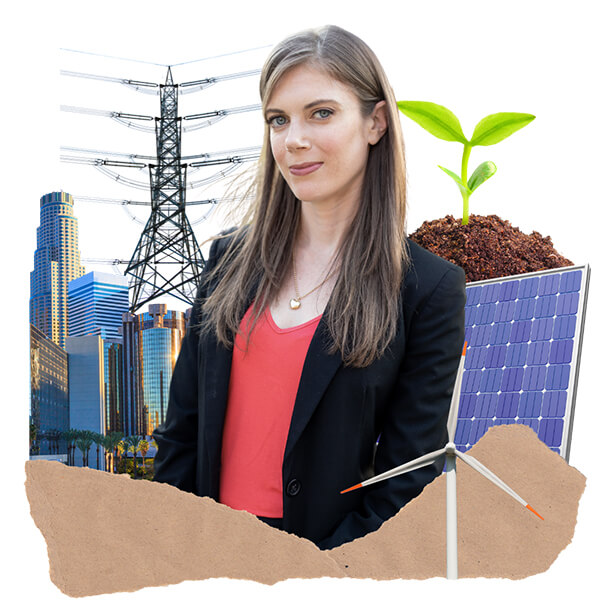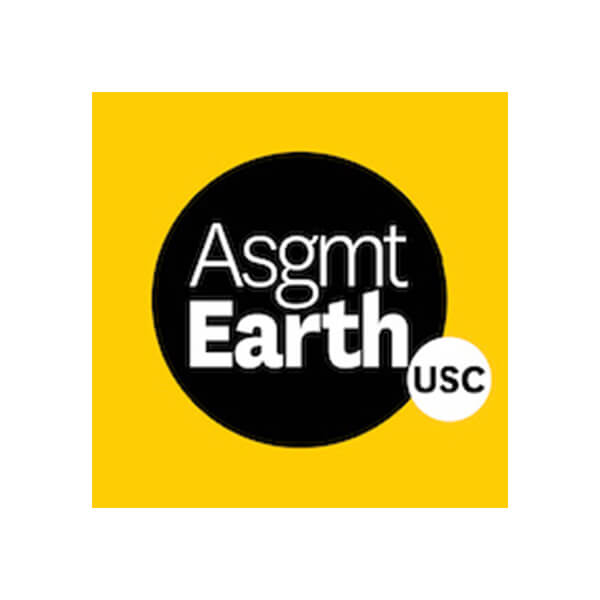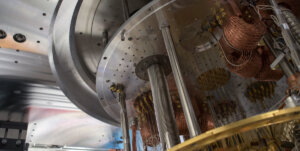
Solar and wind energy farm – a starting point for new green technologies
The problem of the climate crisis is too large to understand as a singular phenomenon – the interconnected impacts are filtering into every aspect of life, from transport efficiency to food security.
The scale of the challenges ahead will require a highly interdisciplinary approach to developing new technologies. That’s exactly what the M.S. in Green Technologies is designed for, equipping students from across USC Viterbi with the mental flexibility and technical know-how they’ll need for future careers on the front lines of climate change and the energy transition.
The Green Technologies program is now administered by USC Sonny Astani Department of Civil & Environmental Engineering (CEE), under the directorship of Kelly Sanders, Dr. Teh Fu Yen Early Career Chair. Sanders’ plan for the program encompasses the comprehensive scope of the CEE strategic vision, which seeks to address global challenges through the lens of environmental stewardship, disaster resilience, extreme habitats, urban livability, and transport service systems.
Kelly took us through the nuts and bolts of the program – what it means not only to teach a curriculum, but to live it.

Kelly Sanders, Dr. Teh Fu Yen Early Career Chair and associate professor of Civil and Environmental Engineering
What makes the M.S. in Green Technologies unique?
Sustainability programs tend to combine various survey courses, for instance in economics or policy, to provide a broad overview of the field. But our Viterbi-wide program is rooted in the fundamentals of engineering – we’re interested in preparing students to apply themselves practically by combining knowledge gathered from multiple domains of engineering.
We have students enrolled from a diversity of academic areas – mechanical engineers, electrical engineers, chemical engineers – and we’re teaching them to think about their own domains through the lens of sustainability, which is a core principle at CEE and Viterbi as a whole.
Another aspect to emphasize is our centralized location within Los Angeles, which is a particularly valuable place to be learning about sustainable engineering. We’re living in an urban ecosystem that will be changing significantly in the coming years; Los Angeles has one of the most aggressive decarbonization plans in the country in terms of its energy systems, as well as progressive thinking around sustainable water use and urban greening. Our classes can support those themes and directly address the challenges faced by the city, broadening that scope to California and the nation at large. We’re living the realities of our curriculum every day, trying to figure out how we can get to a world of primarily renewable energy.
Why is it so important that this M.S. program is interdisciplinary?
First and foremost, it’s worth recognizing that strategies of sustainability are rooted in understanding energy systems. Energy underpins most of our pollution-producing activities, whether that’s driving cars, operating power plants, consuming electricity, or heating and cooling our buildings.
That means you can’t understand energy from the perspective of a singular engineering domain. First, you have to address combustion – but you can’t view energy systems solely from a mechanical engineering perspective, because you have to get to grips with how a power system operates, which is in the domain of electrical engineering. Likewise, you have to examine how electricity is transmitted from a power plant to a building – which brings you to the infrastructure themes of civil engineering, and then to environmental engineering when you consider how pollution affects our environment.
To provide students with the technical toolkit to address energy systems, it’s necessary to bring together multiple domains of engineering, filling an important gap that isn’t often addressed by conventional sustainability programs.

Assignment: Earth is USC’s sustainability framework for creating a healthy, just and thriving campus and world
How is the M.S. program designed to address these embedded elements?
Our plan is to center on the different principles of sustainable energy systems, climate change and lifecycle assessment, and students will select from a range of emphases according to their particular expertise or interest.
To expand upon my previous answer; one emphasis that students can select focuses on combustion and how burning energy creates pollution. Another emphasis is based on power systems – trying to understand how electricity systems work, because electrification is a significant part of the decarbonization movement. Another focuses on sustainable infrastructure systems and buildings from a civil engineering perspective. Then there’s also a pollution emphasis, where we bring in themes from environmental engineering – questions of air chemistry and fluid dynamics that affect the transport of emissions. Students will choose their emphases accordingly, and everyone will take the core curriculum of climate change and lifecycle assessment.
In what way does your own research align with the Green Technologies program?
My B.S. degree, M.S. degree, and PhD degrees are in bioengineering, mechanical engineering and environmental engineering, respectively, so my background is very interdisciplinary. While I teach within environmental engineering, my research analyzes power systems, combustion, buildings, and other infrastructure systems to investigate how energy systems impact the environment.
So, my own interdisciplinary experience and outlook has helped me develop a framework for the program. I asked myself – if a student really wants to understand the multidisciplinary nature of sustainability from an engineering perspective, what type of course curriculum could I put together to truly support that?
What are your hopes for the impact of the program?
One of the things that sets Viterbi apart is the focus on innovation to address global challenges, and we really do have an entrepreneurial student body that recognizes that. I’m hoping that this program fully equips our students with the theoretical and technical foundation to go out into the world and solve these interconnected problems that are facing humanity – a comprehensive set of skills that equates with our students’ motivation and ambition to produce better systems for a greener world.
Published on November 21st, 2023
Last updated on November 27th, 2023











